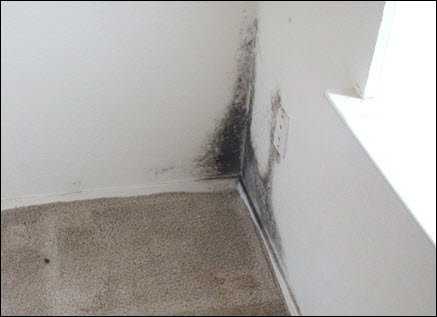articles
Unfairly Blaming Tenants for Interior Mold?
By: Lonnie Haughton
Tel: 510-893-5501
Email Mr. Haughton
View Profile on Experts.com.
Who likely should be blamed for the blackish mold growth found at this new three-bedroom, two-bath apartment in San Jose, California? Unfortunately, landlords often rush to accuse their tenants of generating too much "lifestyle moisture". In many cases, such assessments are both inaccurate and unfair.

Mold Growth at Corner of Family Room Serving a Three-Bedroom, Two-Bath Apartment in San Jose, CA
First, all parties should recognize that tenants generally have the moral and legal rights, within reason, to produce the same levels of lifestyle moisture generated by typical homeowners in comparable spaces. Renters cannot be treated as second-class citizens (as strongly evidenced here in California by the State Housing Law and the Unruh Civil Rights Acts).
Therefore, unless the occupants of this apartment are shown to have been producing highly unreasonable levels of interior moisture, the property manager and building inspectors instead should ask themselves why excessive amounts of water vapor are condensing (i.e., transforming into liquid form) at the drywall surfaces of these corner walls.
Problematic mold growth within residential spaces occurs when high levels of otherwise-harmless water vapor molecules condense at suitable substrates. This transformation of water vapor molecules into liquid water can promote dramatic fungal growth in a manner similar to the effects of watering dry ground that is riddled with dandelion seeds.
- For a simple explanation of water vapor condensation and evaporation processes, see the RA&A Brief: "Water 101 - Contractor's Introduction to the Properties of Water" at: http://www.mastercodeprofessional.com/publications_files/Water-101.pdf.
The typical fungal proliferation seen at these corner walls only results from the condensation of water vapor. Importantly, condensation only occurs at cold surfaces. Therefore, a key to resolving the problem at this apartment was to find out why these walls were unduly cold.
Our subsequent destructive examination of these walls revealed a wide variety of workmanship deficiencies by the original insulation subcontractor and other parties that served to create pathways for exterior air leakage which, during winter months, created cold wall areas at building corners. Subsequent condensation of normal levels of interior lifestyle moisture promoted the fungal growth seen in this photograph. Such substantive construction deficiencies and defects typically constitute actionable violations of modern building and housing codes.
In summary: property managers should not rush to blame occupants for interior mold growth. Let's not use tenants as scapegoats for contractors' failures to comply with current building codes and industry standards.
- For interested readers, key differences between building codes and industry standards are explained in the article "Building Codes, Industry Standards, and Evaluation Reports" at: http://www.rci-online.org/interface/2010-01-haughton-murphy.pdf.
Lonnie Haughton, MCP is the Principal Codes / Construction Consultant at Richard Avelar & Associates, a forensic architectural consulting firm in Oakland, California. He is a CA-licensed General Contractor. Mr. Haughton is Certified by the International Code Council as a Master Code Professional. He is also a Building Inspector, Plans Examiner, and Building Code Official with strong expertise in the California Building Code and, its predecessor, the Uniform Building Code.
©Copyright - All Rights Reserved
DO NOT REPRODUCE WITHOUT WRITTEN PERMISSION BY AUTHOR.


